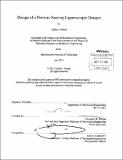| dc.contributor.advisor | Alexander H. Slocum. | en_US |
| dc.contributor.author | Reyda, Caitlin J. (Caitlin Jilaine) | en_US |
| dc.contributor.other | Massachusetts Institute of Technology. Dept. of Mechanical Engineering. | en_US |
| dc.date.accessioned | 2012-01-30T16:55:13Z | |
| dc.date.available | 2012-01-30T16:55:13Z | |
| dc.date.copyright | 2011 | en_US |
| dc.date.issued | 2011 | en_US |
| dc.identifier.uri | http://hdl.handle.net/1721.1/68854 | |
| dc.description | Thesis (S.B.)--Massachusetts Institute of Technology, Dept. of Mechanical Engineering, 2011. | en_US |
| dc.description | Cataloged from PDF version of thesis. | en_US |
| dc.description | Includes bibliographical references (p. 34). | en_US |
| dc.description.abstract | With smaller incisions, laparoscopic, or minimally invasive, surgery is considered safer for patients than open surgery. However, the safety of current laparoscopic grasping instruments can still be improved. Current devices provide surgeons with limited tactile feedback, and the current alligator-style jaws create pinch points that can lead to torn or damaged tissue. Additionally, the angled jaws can result in excessive grasping forces, due to the uneven pressure distribution along the jaws, or slippage when grasping larger organs. Tissue trauma, in the form of mechanical injury (crushing), ischemia (cut off blood supply), or perforation, can occur. A new design uses a symmetric, 10-bar linkage to keep the grasping jaws parallel, creating a uniform pressure distribution along the length of the jaws. A pressure sensor, located near the trigger in the handle, can detect when the grasper jaws are applying too much force on an object. When the force is above a given threshold, a vibration motor in the handle activates, warning the surgeon. This improved tactile feedback can help surgeons control pressures applied during grasping. The grasper design is further enhanced through an ergonomic pistol-grip handle, which also includes a turning wheel to rotate the grasper and a locking mechanism to fix the jaws in place. A working lx scale prototype was built to verify the feasibility of the design. | en_US |
| dc.description.statementofresponsibility | by Caitlin J. Reyda. | en_US |
| dc.format.extent | 36 p. | en_US |
| dc.language.iso | eng | en_US |
| dc.publisher | Massachusetts Institute of Technology | en_US |
| dc.rights | M.I.T. theses are protected by
copyright. They may be viewed from this source for any purpose, but
reproduction or distribution in any format is prohibited without written
permission. See provided URL for inquiries about permission. | en_US |
| dc.rights.uri | http://dspace.mit.edu/handle/1721.1/7582 | en_US |
| dc.subject | Mechanical Engineering. | en_US |
| dc.title | Design of a pressure sensing laparoscopic grasper | en_US |
| dc.type | Thesis | en_US |
| dc.description.degree | S.B. | en_US |
| dc.contributor.department | Massachusetts Institute of Technology. Department of Mechanical Engineering | |
| dc.identifier.oclc | 772628496 | en_US |
